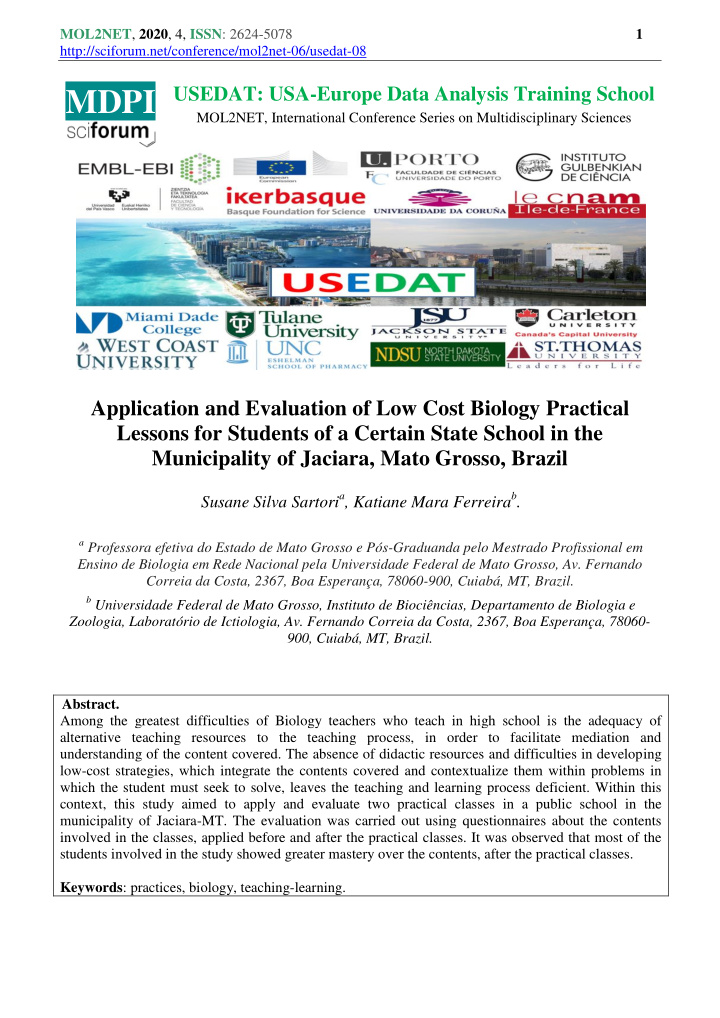



MOL2NET , 2020 , 4, ISSN : 2624-5078 1 http://sciforum.net/conference/mol2net-06/usedat-08 USEDAT: USA-Europe Data Analysis Training School MDPI MOL2NET, International Conference Series on Multidisciplinary Sciences Application and Evaluation of Low Cost Biology Practical Lessons for Students of a Certain State School in the Municipality of Jaciara, Mato Grosso, Brazil Susane Silva Sartori a , Katiane Mara Ferreira b . a Professora efetiva do Estado de Mato Grosso e Pós-Graduanda pelo Mestrado Profissional em Ensino de Biologia em Rede Nacional pela Universidade Federal de Mato Grosso, Av. Fernando Correia da Costa, 2367, Boa Esperança, 78060-900, Cuiabá, MT, Brazil. b Universidade Federal de Mato Grosso, Instituto de Biociências, Departamento de Biologia e Zoologia, Laboratório de Ictiologia, Av. Fernando Correia da Costa, 2367, Boa Esperança, 78060- 900, Cuiabá, MT, Brazil. Abstract. Among the greatest difficulties of Biology teachers who teach in high school is the adequacy of alternative teaching resources to the teaching process, in order to facilitate mediation and understanding of the content covered. The absence of didactic resources and difficulties in developing low-cost strategies, which integrate the contents covered and contextualize them within problems in which the student must seek to solve, leaves the teaching and learning process deficient. Within this context, this study aimed to apply and evaluate two practical classes in a public school in the municipality of Jaciara-MT. The evaluation was carried out using questionnaires about the contents involved in the classes, applied before and after the practical classes. It was observed that most of the students involved in the study showed greater mastery over the contents, after the practical classes. Keywords : practices, biology, teaching-learning.
MOL2NET , 2020 , 4, ISSN : 2624-5078 2 http://sciforum.net/conference/mol2net-06/usedat-08 Introduction Among the greatest needs of Biology teachers when teaching in high school, is the adequacy of alternative teaching resources to the teaching process, in order to facilitate mediation and understanding of the content covered. The absence of didactic resources and difficulties in developing low-cost strategies to improve teaching in Biology is a problem to be thought about and solved (Lima, 2017). One of the most widespread discussions when it comes to the teaching of Biology is related to the choice of methods used by the teacher to address the subjects that involve the discipline. Among the possible methodologies to be used, the theoretical expository class appears among the most used methodologies during the teaching and learning process in Biology. Its choice is justified by the ease of application, since for practical classes and other alternative methods resources and time are required (Silva et al., 2011). Within this context, there is a great need to develop new teaching strategies in low- cost biology, since the traditional teaching method, lectured, is outdated (Carvalho, 2018). Educational institutions are going through a time when there is a real need to plan new pedagogical methods, at a more accessible cost and in order to improve teaching and learning, motivating teachers and participants to seek efficiency in their studies (Miter, 2008). In view of the discussions about the teaching model practiced by several institutions, other issues related to this theme were also taken into consideration, such as the teaching strategies employed, an extremely relevant part in the teaching-learning process, because, for this to occur, effectively, teaching methodologies must be very well adjusted (Giovanella, 2007). It is the responsibility of teachers to provide their students with effective learning experiences, combating the most common difficulties and updating, as much as possible, the pedagogical instruments they use (Fiolhais & Trindade, 2003). The teacher's role is to provide students with the construction of meaningful learning. The way teaching and learning situations are proposed is decisive for meaningful learning to materialize (Giovanella, 2007). The changes and transformations of the agents make the transmission of knowledge a very dynamic process, which requires permanent monitoring and the permanent search for new practices, aimed at breaking paradigms (Barbosa & Moura, 2013). In addition to obtaining effective teaching tools for successful learning, there is still a need to educate within the scientific basis, since new knowledge has been surprisingly generated, thus emerging a reality that directly influences traditional education putting it in a situation dramatic. For a country to develop harmoniously, sustainably and be within a globalized world, its population must have a level of scientific literacy, considerably good (Rocha & Soares, 2005). An alternative pedagogical practice to traditional teaching that has gained prominence in the educational environment is the active methodology. Instead of teaching based on the transmission of information, where the teacher acts as a protagonist, in the active methodology, the participant adopts a more active, participatory posture, in which he elaborates solutions to problems, creates and develops projects and, with that, forms the possibility of creation and not just the reproduction of knowledge (Valente, 2017; Schneider, 2013). Within the active methodology, it is not up to the teacher, the transmission of ready and conceptual speeches, but the organization and mediation of previously organized and sequenced activities that start from problems that students must solve, individually or in groups (Suhr, 2016; Santiago & Carvalho, 2018). Another relevant factor that can contribute effectively to the development of teaching strategies is the advancement of information and communication technologies (ICT), which have transformed some teaching and learning methodologies. The ICT gives teachers and students the opportunity to establish contact with different media, improving the understanding of information, thus allowing the development of a new teaching-learning methodology (Assis, 2015).
Recommend
More recommend